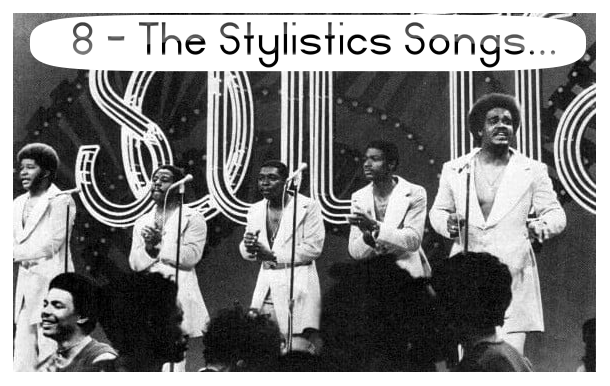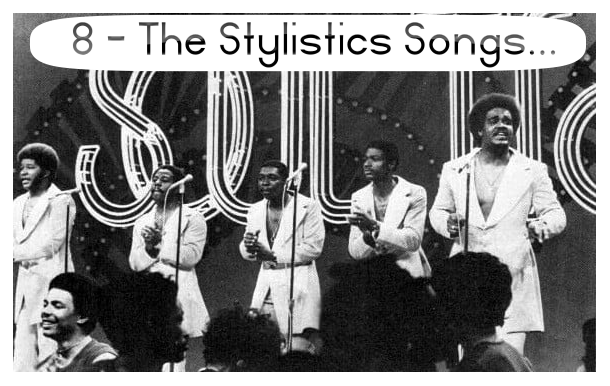-
 play_arrow
play_arrow
Praise 24/7 NO Today's Best Gospel
(ThyBlackMan.com) Few groups in soul music history embodied the essence of smooth, romantic balladry the way The Stylistics did. Emerging in the early 1970s, the Philadelphia-bred vocal harmony group brought together soaring falsettos, lush orchestral arrangements, and lyrics that perfectly captured matters of the heart. Guided by the production brilliance of Thom Bell early on, The Stylistics cemented their reputation as masters of tender storytelling.
What makes their catalog endure is not just nostalgia for an era of slow dances and candlelit nights. Their songs possess a craftsmanship and universality that still resonates with listeners across generations. When you press play today, you don’t just hear oldies—you experience timeless music that transcends its moment. Below are eight songs that showcase The Stylistics’ unmatched artistry and why they remain essential listening.

1. “You Make Me Feel Brand New”
What sets “You Make Me Feel Brand New” apart from other love songs of its era is the duality of voices and perspectives. Unlike many Stylistics recordings where Russell Thompkins Jr.’s falsetto dominates, this track emphasizes balance. Airrion Love’s deep baritone doesn’t merely serve as harmony—it feels like an anchor, grounding the floating vulnerability of Thompkins’ high register. This interplay between high and low mirrors the very essence of relationships: two different voices, two different spirits, united in a single declaration of love.
The production also deserves attention. Thom Bell’s arrangement layers the orchestra in a way that feels both intimate and expansive. Each swell of strings arrives like a wave of emotion, underscoring the song’s devotional message. There’s a spiritual quality to the track, as though the singers are giving thanks not just to a partner, but to life itself. For this reason, it has often been played not just at weddings, but also at religious services and memorials—a testament to its universality.
When played today, the song can be experienced in different contexts. For older fans, it recalls a time of heartfelt slow jams and tender soul radio programs. For younger audiences, its timeless sincerity offers a counterpoint to fleeting modern love anthems that often lack staying power. Its message—that love has the power to renew and restore—is one that transcends generations.
“You Make Me Feel Brand New” has also influenced artists across genres. From gospel choirs to contemporary R&B vocalists, the structure of the song—the interplay of voices, the swelling arrangements—remains a template. Listening in 2025 or beyond, it remains more than a ballad: it’s an anthem of gratitude and proof that the simplest declarations of appreciation are often the most profound.
2. “Betcha by Golly, Wow”
“Betcha by Golly, Wow” thrives on understatement. While some soul ballads rely on dramatic crescendos, this track succeeds by staying soft, almost whisper-like. The vulnerability in Thompkins’ falsetto feels so delicate that it borders on conversational intimacy. It’s as though he’s singing directly into the listener’s ear, transforming the song into something private rather than public.
What makes it remarkable is the poetic nature of its lyrics. Instead of blunt declarations, the song opts for metaphors and imagery—comparing love to the wonders of the world, elevating personal emotion into the realm of universal truth. That’s why it still resonates: it avoids dating itself with slang or overused expressions, and instead leans into timeless language that any listener can interpret.
The arrangement complements this poetic approach. The strings glide like brushstrokes on canvas, never overwhelming the vocals but providing the perfect frame. The rhythm section maintains a gentle pulse, allowing the falsetto to remain front and center. It’s a masterclass in restraint, showing that emotional weight doesn’t always require heavy instrumentation.
Decades later, “Betcha by Golly, Wow” has been covered, sampled, and referenced countless times. Yet no interpretation has matched the sheer tenderness of the original. In today’s streaming world, where listeners seek “vibe playlists” for relaxation, romance, or introspection, this song naturally fits. It’s a track that can fill a quiet room with warmth, proving that subtlety and softness carry enduring power.
3. “Break Up to Make Up”
The genius of “Break Up to Make Up” lies in its brutal honesty. Instead of pretending that love is a perfect, uninterrupted journey, it lays bare the cycles of argument, reconciliation, and fragile peace. The phrase “that’s all we do” suggests exhaustion, but also dependence—it’s an acknowledgment that passion and dysfunction often coexist.
The emotional weight of the song comes from the contrast between its lush arrangement and the weary truth of its lyrics. Thompkins’ falsetto trembles with vulnerability, as though he’s both resigned and still hopeful. The background harmonies add layers of empathy, echoing the experience of many couples who can’t seem to let go despite constant conflict.
What makes the song resonate even more today is its relatability in the age of on-again, off-again relationships. Modern love stories often play out on social media in cycles of public breakups and reconciliations. “Break Up to Make Up” predates all of this but captures the same emotional loop with elegance and compassion. Listening to it now is almost eerie—it feels like a soundtrack for contemporary relationship struggles, even though it was written decades ago.
For anyone who has experienced that tug-of-war of love, this track is cathartic. It doesn’t glorify the dysfunction, but it doesn’t deny the attachment either. It acknowledges that love is complicated, that it can be both painful and irresistible. That honesty gives the song its timeless weight, making it not just a ballad of its era, but a mirror for listeners in any age.
4. “Stop, Look, Listen (To Your Heart)”
Unlike some of the group’s heavier ballads, “Stop, Look, Listen (To Your Heart)” feels almost conversational, as though Thompkins is offering advice to someone hesitating on the edge of love. The melody is straightforward, and the lyrics are direct, but the delivery transforms them into something deeper. Each falsetto note is less of a plea and more of a gentle nudge toward vulnerability.
The strength of the song lies in its universal message. Everyone, at some point, has hesitated to open up, fearing rejection or disappointment. This track addresses that hesitation with compassion. The title itself acts as a mantra—stop rushing, look at what’s in front of you, and listen to what your heart is telling you. That advice applies not just to romance but to life decisions in general, which is why the song continues to resonate.
Musically, the orchestration elevates the message. The strings are gentle, never overwhelming, while the rhythm keeps the pace steady and calm. It’s a song designed to soothe as much as inspire. This dual purpose—comfort and encouragement—makes it versatile. It can be enjoyed in moments of solitude, or shared between two people on the cusp of deeper connection.
Over time, the track has taken on new meaning. For listeners today, surrounded by noise and constant distraction, its reminder to slow down and pay attention feels almost radical. It’s not a grand, sweeping ballad like “You Make Me Feel Brand New,” but rather a subtle meditation on presence. That subtlety is precisely why it endures, offering each generation a moment of pause amid the rush of life.
5. “Let’s Put It All Together”
What makes “Let’s Put It All Together” stand out is its sense of optimism without slipping into naivety. The Stylistics present reconciliation as something worth striving for, not as a fairy tale but as a deliberate choice. The lyrics emphasize cooperation and unity, showing that love requires patience, forgiveness, and a willingness to meet halfway. This message makes it one of the group’s more hopeful songs, a counterbalance to their bittersweet catalog.
The music builds this atmosphere of optimism carefully. The arrangement feels lighter, with a subtle bounce in the rhythm section and a chorus that rises with genuine joy. The layered harmonies are particularly important here—they feel communal, reinforcing the idea that unity isn’t just about two people, but about voices blending together in harmony. Each vocal layer carries warmth, pulling the listener into the message of reconciliation.
Even in a modern setting, this song offers a refreshing reminder of the beauty of compromise. In an era when relationships are often portrayed through conflict-driven television dramas or short-lived social media flings, “Let’s Put It All Together” feels refreshing. It insists that love can be steady, uplifting, and nourishing. Couples still find comfort in its message when navigating difficult moments, as it frames reconciliation as a celebration rather than defeat.
The track also shows how versatile The Stylistics were in tone and mood. Known primarily for melancholic ballads, here they demonstrate their ability to write uplifting anthems without losing depth. “Let’s Put It All Together” expands the group’s emotional range, ensuring that their catalog remains relevant to listeners who want to experience both the highs and lows of love through music.
6. “People Make the World Go Round”
Unlike many of their hits, “People Make the World Go Round” directs its gaze outward, turning social critique into song. The references to garbage strikes, dishonest politicians, and rising costs reflect the frustrations of the early 1970s, but the track’s power comes from how relatable it still feels. The Stylistics didn’t just sing about love—they gave voice to the everyday struggles that affect entire communities.
Musically, the song is darker than much of their romantic work. The string arrangement carries a tense, almost cinematic quality, while the rhythm is more restrained. Thompkins’ falsetto, usually associated with sweetness, takes on a tone of weary resignation, highlighting the weight of disillusionment. This shift in delivery proves the flexibility of his voice—it could capture tenderness, but also the heaviness of social reality.
Today, the track resonates as much as ever. Lines about greed, inequality, and corruption strike a familiar chord in a world still dealing with many of the same issues. Younger listeners who stumble upon it might be struck by how contemporary it feels, almost as if it were written with modern headlines in mind. That relevance keeps the song alive in playlists that focus on socially aware soul and R&B.
By venturing into social commentary, The Stylistics broadened their artistry. This song demonstrates that their lush sound could frame not just love stories, but societal truths. It’s a testament to the depth of Philadelphia soul—that even within a genre associated with romance, there was room for songs that spoke to the challenges of daily life.
Finish story here; 8 The Stylistics Songs That Still Touch the Heart.
Written by: Black Gospel Radio
Similar posts
-

Praise 24/7 Commercial Free
For every Show page the timetable is auomatically generated from the schedule, and you can set automatic carousels of Podcasts, Articles and Charts by simply choosing a category. Curabitur id lacus felis. Sed justo mauris, auctor eget tellus nec, pellentesque varius mauris. Sed eu congue nulla, et tincidunt justo. Aliquam semper faucibus odio id varius. Suspendisse varius laoreet sodales.
close Top popular

The Science of Happiness – Exploring Factors for Well-Being

Balancing Act: Prioritizing Your Well-Being in a Busy World

Overcoming Procrastination – Strategies for Productivity and Success

Unlocking Hidden Potential – A Guide to Personal Growth

Mindful Living – Cultivating Presence in the Modern Era

CONTACT US
- info@praise247no.com
FOLLOW US
- Praise247NO
- Praise247NO
- Praise247NO
Copyright 2024 Praise247no.com - All Rights Reserved.





Post comments (0)